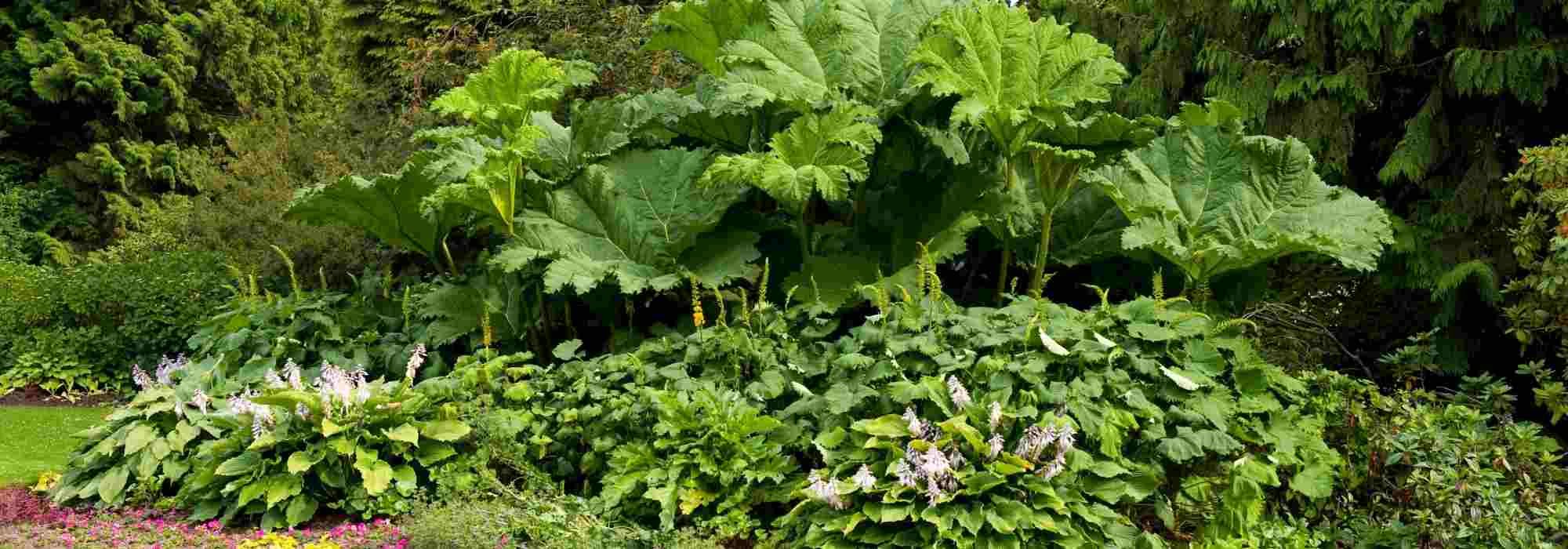
How to create a successful foliage border?
Invite beautiful foliage into shady areas of your garden
Contents
In the garden, flowering is often short-lived, while foliage remains in place for many months, even all year when chosen evergreen. They allow creation of verdant, exuberant or intimate planting beds depending on chosen varieties. Ferns, Hostas, Mahonias, Farfugiums, Gunneras, Brunneras…. Ornamental foliage is found in many species and displays very diverse forms. It is very interesting to showcase them in planting beds in shaded areas of the garden. These are often large-format leaves that are best suited to a shaded or semi-shaded aspect: generally originating from tropical regions, these plants that favour soils that remain cool bring a sense of luxuriant abundance, between vegetative cover and very bold volumes.
Richness of colours, ample or lobed forms, fineness of textures… Dare to use the full potential of foliage from perennials and bushes to create distinctive planting beds that will reveal shaded areas of your garden.
Focus on diversity of forms
Mother Nature has endowed foliage with a remarkable diversity of shapes and sizes. It can fill borders or low hedges for the smaller plants, and form entire beds for the more generous ones. The largest laminae (main part of the leaf) are found in plants of tropical origin or in understorey species: to capture maximum light (to perform optimal photosynthesis) these plants have developed a large leaf surface area. They are ideal for adding lots of volume and luxuriance, for example with the broad, rounded leaves of hostas (some are giant), Petasites (including the giant Petasites giganteus), Farfugiums, etc…
Even more generous, the deeply divided foliage of Gunneras is a real invitation to travel, transporting you into a tropical atmosphere. If you lack the space these magnificent giants demand, ornamental rhubarbs (Rheum palmatum), Acanthus, Astilboides and other Fatsias will also make a strong impact. Take care, however, to introduce these spectacular foliage plants sparingly so they are not lost in the composition.
These divided leaves look splendid paired with finer or more tapered foliage, for example that of ferns, Choisyas ‘Aztec Pearl’, Sorbaria sorbifolia or Mahonia confusa (‘Soft Caress’, ‘Nara Hiri’), which helps create a strong contrast within a bed.
Also rely on the linear and strap-shaped foliage of many perennials or bulbous plants: these forms bring a great deal of dynamism when they are broader (Aspidistras, Hedychiums, Zantedeschia aethiopica…), and flexibility and lightness when they are finer (Iris foetidus, Hakonechloa, Liriopes, grasses…).
Finally, palmate or palmately lobed foliage is useful if you want to introduce an even stronger exotic note: many modest-sized, hardy palms take to foliage beds without difficulty, such as dwarf Sabals or the Needle palm. Tetrapanax, in XXL size, is enough to inject a profusion of vegetation; Rodgersias and Darmera peltata are always magnificent in moist soil.
You will achieve good balance in your bed by pairing these bold foliage plants with more restrained foliage (small groundcovers, hardy geraniums…) which will help showcase them.
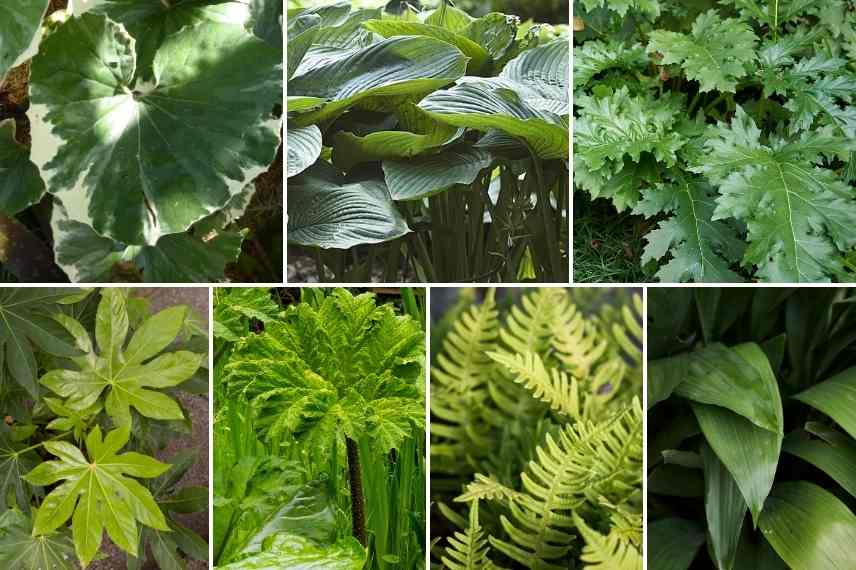
Farfugium japonicum ‘Argenteum, Hosta ‘Empress Wu’, Acanthus, Fatsia japonica, Gunnera manicata, Ferns, Aspidistra eliator
Play with volumes
All these plants vary greatly in size, and you will need to think in terms of volumes to create a harmonious border. Plant some low evergreen plants at the edge such as the Japanese-style Ophiopogons, Carex and Hakonechloas, or the delicate hardy geraniums or some Bergenias. You can also introduce as groundcover Pachysandra terminalis with attractive divided leaves, or the prolific Bégonia grandis with its exotic temperament bringing delicate pale flowering all summer, large-leaved Brunneras or Heucheras and alchemillas planted en masse.
Choice is wide for taller plants that will be placed in the middle or back of the border: Arums, Euonymus, Fatsias, Choisyas ternata, Nandinas domestica, Mahonias, Hebes, Loropetalums, Dicksonia antartica and Tetrapanax to add height, etc….
Mix upright and bushy forms, such as fern fronds and foliage of a purple Berberis or a ball of box or Muehlenbeckia, or the rounded leaves of Hostas with the exuberant scale of a Gunnera: it is the silhouette of plants that should be contrasted.
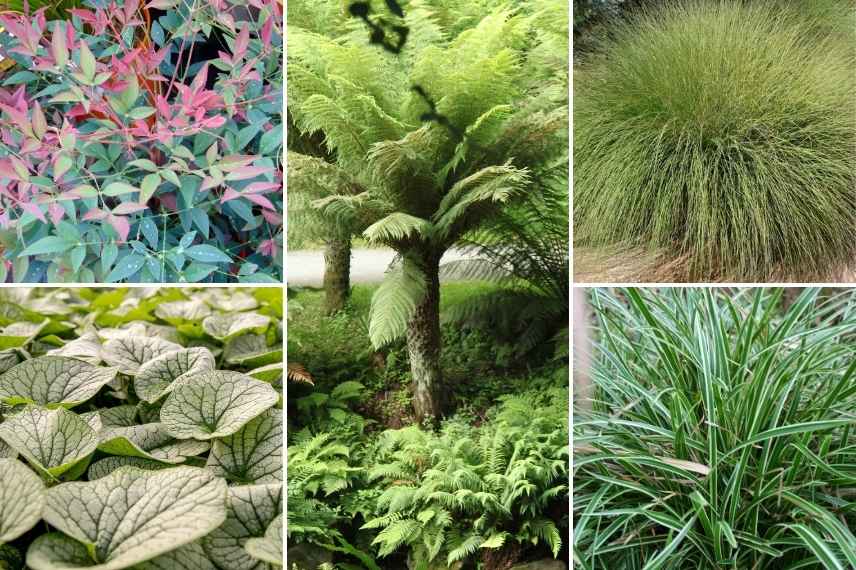
Nandina domestica ‘Obessed Seika’ Brunnera ‘Alexander’s Great’, Dicksonia antartica, grass cushion, Carex morrowii
An extraordinary colour chart
Greens are manifold in vegetable kingdom, and composing a foliage border is highly worthwhile when combining them harmoniously, creating contrasts and pairings.
Sometimes variegated or speckled with cream, yellow or pink, striate or marginate, their shades range from bluish (referred to as glaucous green) in many hostas, to grey or silver for Brunnera macrophylla, or acidic (very bright yellow-green as in Hachonekloa or inflorescences of Euphorbia amygdaloides), clear green or light green, up to red, purple and black. It is this whole palette that is interesting to exploit in a border that showcases foliage! In shaded borders where larger leaves are used more, one generally finds clear greens, yellows, variegated and blacks.
By combining two or three shades at most you achieve a lovely effect. Foliage can also change and take different tones according to season like Nandinas and Bergenias that redden in cold… They work wonders when designing a border where they are highlighted and showcased. Bear in mind that variegated foliage (such as some Hostas, Acers, …) readily tolerates a little more sun to retain that beautiful characteristic. The most striking dark tones, such as purple and black, should be used sparingly, as they tend to darken the area. Bluish foliage of some hostas prefers a part-shade position, as too much shade reduces intensity of colour. Yellow-variegated foliage also requires a little more sun.
Cream-variegated foliage (Acanthus ‘Whitewater’, Euphorbia polychroma ‘Variegata’, some hostas) serves as a link between two different greens. This link can be provided by a white inflorescence, which many plants with remarkable foliage produce.
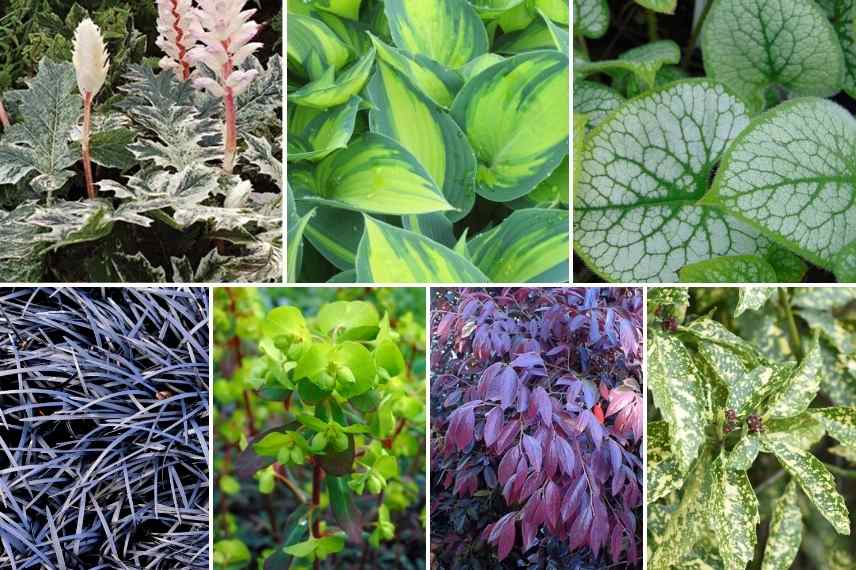
Acanthus ‘Whitewater’, Hosta ‘June’, Brunnera ‘Jack Frost’, Ophiopogon planiscapus ‘Nigrescens’, Euphorbia amygaloides ‘Purpurea’, Loropetalum ‘Pipa’s Red’ , Aucuba japonica
Mix foliage textures
Foliage texture is rich and also adds graphic appeal to your border!
Velvety leaves of Brunneras, crinkled leaves of the Hydrangea macrophylla ‘Tricolor’ or of Podophyllums, thorny leaves of hollies or Mahonias, glossy leaves of Aucubas, silky fronds of Dicksonias antartica, airy fronds of Asplenium trichomanes, veined leaves of hostas… A multitude of textures exists, allowing them to be combined and contrasted. Plant glossy or matt foliage, tough and supple, side by side, repeating this kind of motif with your favourite plants to create an attractive foliage border.
Mixing and juxtaposing fine and broader foliage also contributes to this interplay of textures.
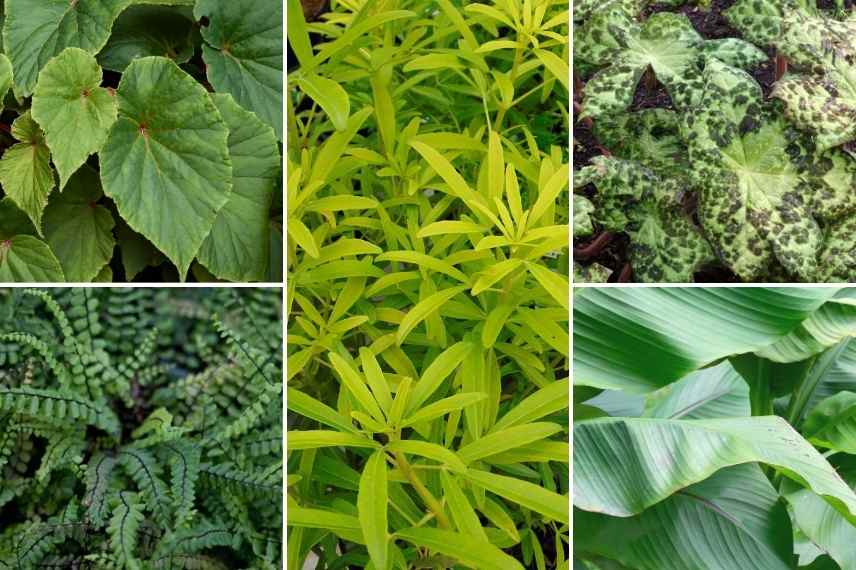
Begonia grandis ‘Envasiana’, Asplenium trichomanes, Choisya ternata ‘Aztec Gold’, Podophyllum ‘Spotty Dotty’, Musa
A few landscaping tips
If some foliage-interest plants produce flowers, these are generally ethereal, blending into greenery, as with Heuchères, Mahonias or Liriopes, and often white, creating links as with Choisyas or Hostas. Compose your planting by introducing them in small touches (white, pink most often) and by choosing a single flower colour; they will bring grace and much softness. Arums, with much more conspicuous flowers, are perfect for showcasing the rest of the scene. If you opt for an exotic planting, orange-flowering plants such as Epidmediums, Hedychiums, Hemerocalles or Alstromères can be used in monochrome, bringing brightness and creating a profusion of greenery with their generous foliage.
Use light as a colour revealer: place some very veined, narrow or palmate leaves in filtered morning or evening light, and play with transparency on the large leaves of Gunneras, ferns, Begonias grandis, Alocasias… : sun brings even more radiance to these remarkable leaves!
With mainly evergreen foliage, combine some semi-evergreen and deciduous foliage to enjoy fresh spring leafing and to renew your planting through the seasons.
In mild climates, don’t hesitate to combine tropical or frost-tender plants that you will plant in open ground (Musas, Coprosmas, Melianthus, Strelitzias, Arundo donax…) and, in waterlogged soil or in a pond, combine Thalias, Papyrus, horsetail, etc.
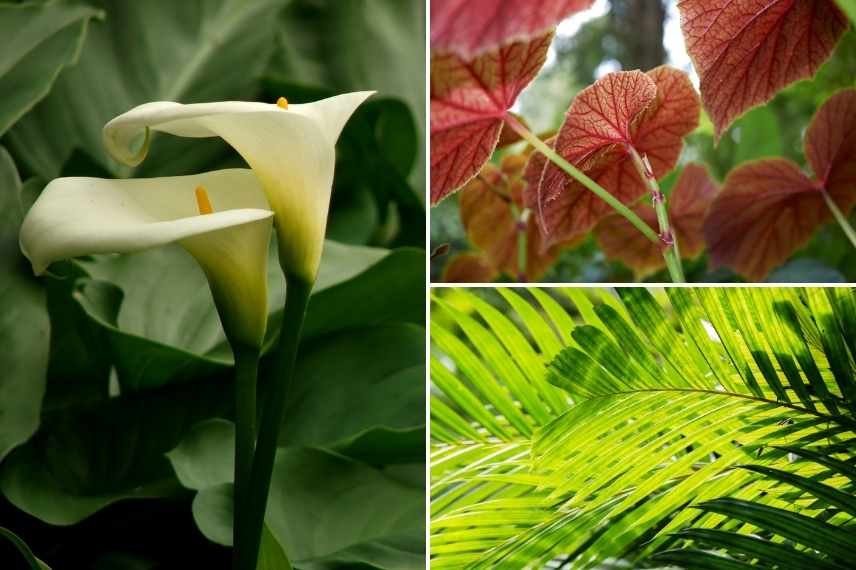
Graphic, solemn white spathes of Arums do not jar in a planting of foliage. Create plays of light to reveal beauty of foliage (here in Begonias grandis and palm foliage)
- Subscribe!
- Contents
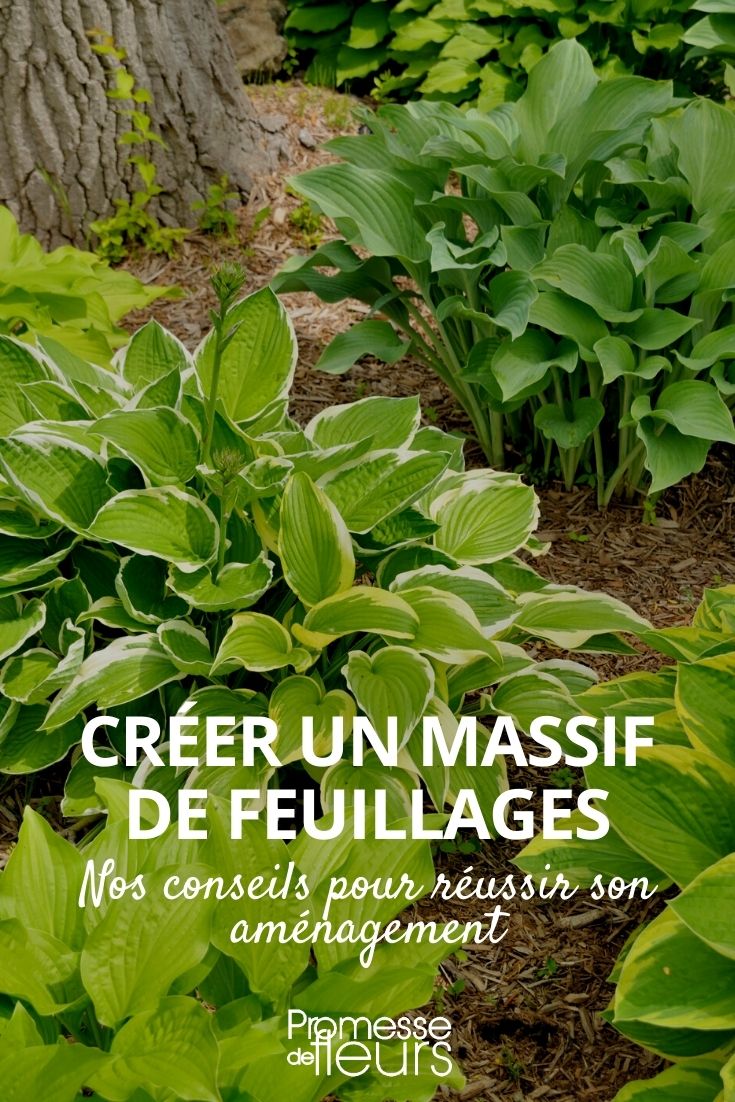































Comments